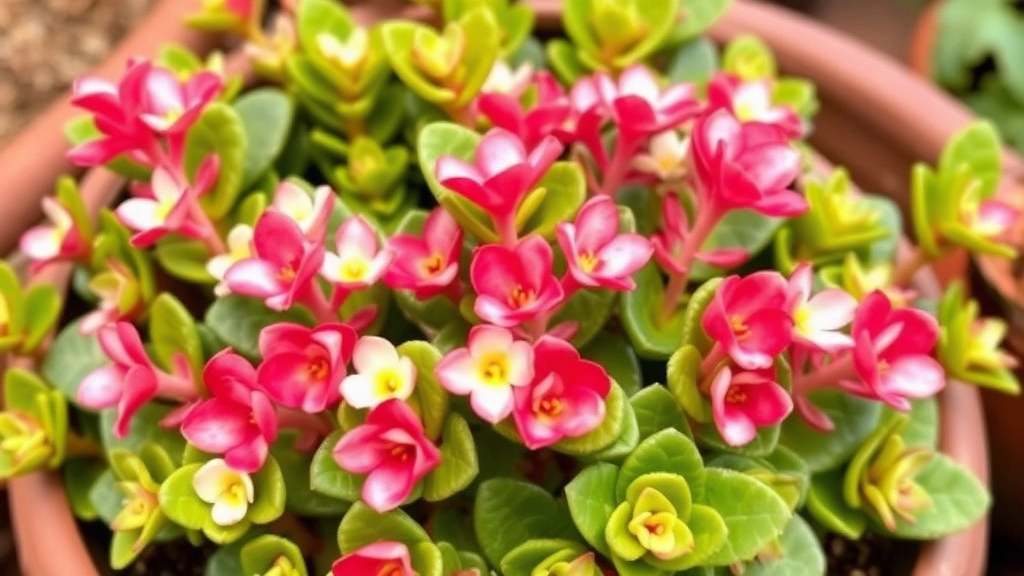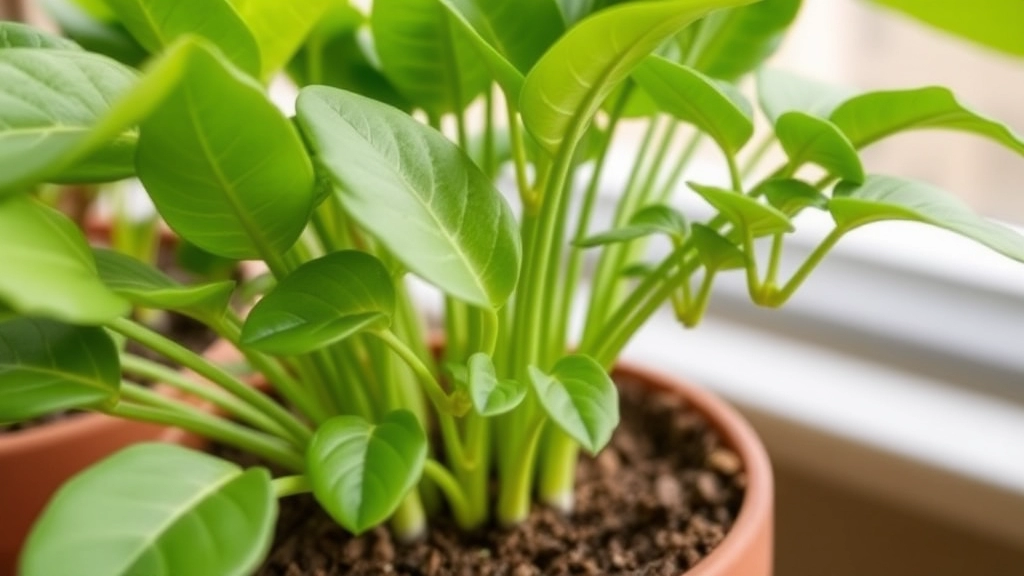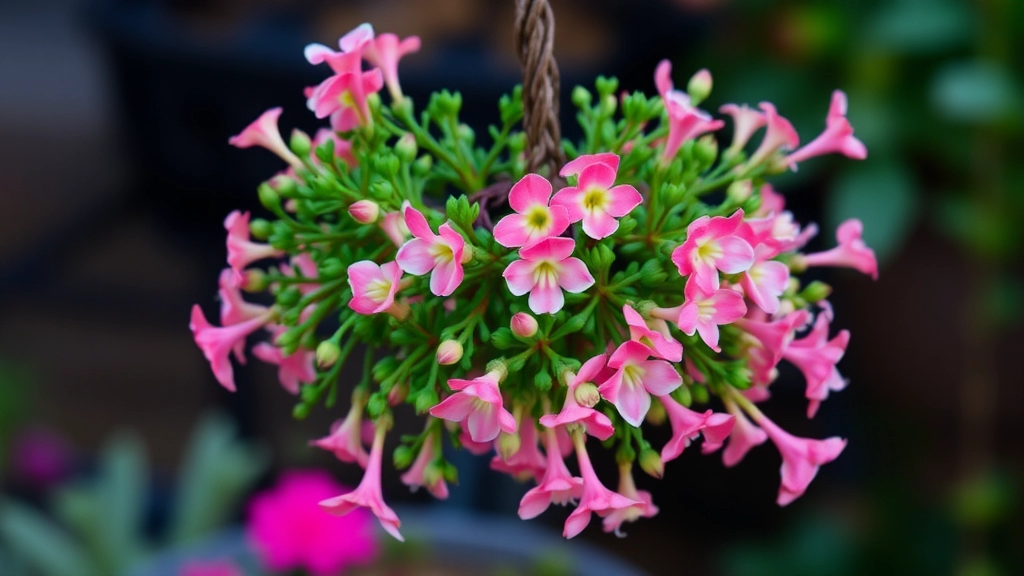Chandelier Plant Kalanchoe Tubiflora
If you’re looking to add a unique touch to your succulent collection, the Chandelier Plant Kalanchoe Tubiflora, also known as Mother of Millions, is a fantastic choice. This intriguing plant is not only visually striking but also relatively easy to care for, making it a favourite among both novice and experienced gardeners.
Care Requirements
To ensure your Kalanchoe Tubiflora thrives, it’s essential to understand its specific needs. From optimal growing conditions and light requirements to proper watering techniques and pest management, this guide will cover everything you need to know. Whether you’re interested in propagation methods or dealing with its invasive tendencies, we’ve got you covered.
Optimal Growing Conditions for Kalanchoe Tubiflora
Are you struggling to keep your Kalanchoe Tubiflora thriving?
Understanding the optimal growing conditions for this resilient succulent can make all the difference.
Kalanchoe Tubiflora, also known as Mother of Thousands, flourishes in environments that mimic its native tropical habitat.
Key Factors for Optimal Growth
- Light:
- This plant loves bright, indirect sunlight.
- Direct afternoon sun can scorch its leaves, so a spot with filtered light is ideal.
- Temperature:
- Kalanchoe Tubiflora prefers temperatures between 20°C to 30°C.
- It can tolerate cooler temperatures but should be protected from frost. For more detailed guidance, check out the ideal temperature for Kalanchoe Blossfeldiana growth.
- Humidity:
- This succulent thrives in low to moderate humidity levels.
- Avoid overly humid environments to prevent rot.
- Air Circulation:
- Good airflow is crucial.
- Avoid overcrowding your plants to ensure they can breathe. Learn more about how to propagate Kalanchoe Mother of Thousands to make the most of your space.
- Seasonal Changes:
- During the growing season (spring and summer), ensure they receive ample light and warmth.
- In autumn and winter, reduce watering and allow the plant to rest.
Light and Temperature Requirements

Are you wondering why your Kalanchoe tubiflora isn’t thriving? One of the key secrets lies in its light and temperature needs.
Light Requirements
Kalanchoe tubiflora loves bright, indirect sunlight.
- Ideal Spot: A south or east-facing window is perfect.
- Too Much Sun: Direct sunlight can scorch the leaves, turning them crispy.
- Too Little Light: If it’s not getting enough light, you might notice leggy growth and fewer flowers.
Temperature Preferences
This succulent thrives in warm conditions, making it a great choice for indoor gardening.
- Optimal Range: Aim for temperatures between 20°C to 25°C (68°F to 77°F).
- Cold Sensitivity: It doesn’t like it below 10°C (50°F). If it gets too chilly, it might drop its leaves.
- Seasonal Changes: During winter, keep it away from drafty windows or doors.
Quick Tips for Success
- Rotate Your Plant: Give it a gentle twist every few weeks to ensure even growth.
- Monitor the Temperature: Use a thermometer to keep an eye on the room’s warmth.
- Watch for Signs: Yellowing leaves can indicate too much or too little light.
Soil and Watering Techniques for Healthy Growth
When it comes to cultivating Kalanchoe Tubiflora, the right soil and watering techniques are essential for thriving plants. Many enthusiasts often wonder why their Kalanchoe isn’t growing as expected. The answer often lies in these two critical areas.
Soil Requirements
Kalanchoe Tubiflora thrives best in well-draining soil. This prevents root rot, a common issue with succulents. Here are some key points to consider:
- Soil Type: Use a cactus or succulent potting mix. You can also create your own by mixing regular potting soil with sand or perlite.
- pH Level: Aim for a slightly acidic to neutral pH, ideally between 6.0 and 7.0.
- Pot Choice: Ensure your pot has drainage holes. This is crucial for preventing excess moisture.
Watering Techniques
Watering is another area where many plant owners struggle. Overwatering is a common mistake that can lead to serious issues. To ensure your Kalanchoe Tubiflora remains healthy:
- Frequency: Water only when the top inch of soil feels dry. This could be every 2-3 weeks, depending on your climate.
- Method: Water thoroughly until it drains from the bottom. Avoid letting the plant sit in water.
- Seasonal Adjustments: Reduce watering in winter when the plant is dormant.
For more detailed care tips, check out our Chandelier Plant Kalanchoe Tubiflora Care Guide. Additionally, understanding the ideal temperature for Kalanchoe growth can further enhance your plant’s health.
Fertilizing Kalanchoe Tubiflora: When and How

Many plant enthusiasts often wonder, “When should I fertilize my Kalanchoe Tubiflora?” and “What type of fertiliser is best?” These questions are crucial for ensuring your plant thrives.
Timing is Key
- Growing Season: Fertilize during the active growing season, which typically spans from spring to early autumn. This is when your Kalanchoe is most receptive to nutrients.
- Frequency: Aim to fertilize every 4-6 weeks. Over-fertilising can lead to salt build-up, harming the plant.
Choosing the Right Fertiliser
- Balanced Fertiliser: Opt for a balanced, water-soluble fertiliser with an NPK ratio of 20-20-20. This provides essential nutrients evenly.
- Dilution: Always dilute the fertiliser to half-strength. This prevents fertiliser burn, which can damage the delicate roots.
Application Techniques
- Watering First: Before applying fertiliser, water your Kalanchoe. This helps the soil absorb nutrients effectively.
- Even Distribution: Pour the diluted fertiliser evenly around the base of the plant, avoiding direct contact with the leaves.
Signs of Nutrient Deficiency
Keep an eye on your plant. If you notice yellowing leaves or stunted growth, it might be time to adjust your fertilisation routine.
## Pruning and Shaping Techniques
When cultivating Kalanchoe Tubiflora, you may find yourself wondering how to maintain its shape and encourage healthy growth. Pruning is not just about aesthetics; it plays a crucial role in the plant’s overall health.
### Why Prune Kalanchoe Tubiflora?
– **Encourages bushier growth**: Regular pruning helps the plant to branch out, resulting in a fuller appearance.
– **Removes dead or damaged leaves**: This prevents diseases and pests from taking hold.
– **Promotes flowering**: Pruning can stimulate the plant to produce more blooms.
### When to Prune
– **Spring**: The best time to prune is in early spring, just before the growing season begins. This allows the plant to recover quickly and flourish.
– **After flowering**: If you notice the flowers fading, it’s a good time to trim back any spent blooms.
### How to Prune
1. **Tools**: Use sharp, clean scissors or pruning shears to avoid damaging the plant.
2. **Identify**: Look for:
– Dead or yellowing leaves
– Overly long stems
– Spent flowers
3. **Cut**:
– Trim back stems to just above a leaf node.
– Remove any leaves that are brown or wilting.
4. **Shape**: Aim for a balanced shape by cutting back longer stems more than shorter ones.
### Tips for Shaping
– **Maintain height**: If your Kalanchoe Tubiflora is getting too tall, don’t hesitate to cut back the top growth.
– **Encourage lateral growth**: Focus on trimming the outer branches to promote a bushier appearance.
– **Regular maintenance**: Make pruning a routine part of your plant care every few months.
For more detailed guidance on Kalanchoe care, check out this [Kalanchoe Tubiflora Care Guide](https://planthq.org/kalanchoe-brasiliensis-care-complete-guide-for-thriving-plants/). Additionally, you might find useful tips in this [Pruning Kalanchoe Plants Guide](https://planthq.org/pruning-kalanchoe-plants-best-tips-and-techniques/).
Propagation Methods: From Plantlets to Stem Cuttings

So, you’ve got your Kalanchoe Tubiflora thriving, and now you’re wondering how to multiply that beauty, right?
Propagation is a fantastic way to expand your collection or share the love with friends.
Plantlets: The Easiest Way to Start
Kalanchoe Tubiflora is known for its unique plantlets that sprout along the edges of its leaves. Here’s how to get started:
- Identify Healthy Leaves: Look for mature leaves with plantlets. They should be plump and vibrant.
- Gently Remove the Leaf: Use clean scissors to snip the leaf, ensuring you don’t damage the plantlet.
- Let It Callous: Place the leaf in a dry spot for a day or two. This helps prevent rot when it’s planted.
- Planting: Once calloused, place the leaf on top of well-draining soil, gently pressing the plantlets into the soil.
- Water Sparingly: Mist the soil lightly until roots develop, which usually takes a couple of weeks.
Stem Cuttings: A Classic Approach
If you’re after a more traditional method, stem cuttings work wonders too. Here’s the lowdown:
- Choose a Healthy Stem: Look for a stem that’s firm and green. Avoid any that show signs of disease or damage.
- Cut at an Angle: Use clean scissors to make a diagonal cut just below a leaf node.
- Let It Callous: Just like with the leaves, let the cutting sit for a day or so.
- Planting: Insert the cutting into well-draining soil, burying it about an inch deep.
- Watering: Water it lightly and place it in a warm, bright area, but out of direct sunlight.
Tips for Successful Propagation
- Humidity is Key: Covering your cuttings with a plastic bag can help maintain humidity.
- Be Patient: Rooting can take a few weeks, so don’t rush the process.
- Check for Roots: Gently tug on the cutting after a few weeks; if there’s resistance, roots are forming!
As we delve deeper into the care of Kalanchoe Tubiflora, it’s essential to address a pressing concern for many plant lovers: pests and diseases.
### Common Pests
Kalanchoe Tubiflora can attract a few pesky intruders. Here are the most common ones you might encounter:
– **Aphids**: Tiny green or black insects that can cluster on new growth, sucking sap and causing leaves to curl.
– **Mealybugs**: White, cottony pests that hide in leaf axils and on stems, leading to yellowing leaves.
– **Spider Mites**: These tiny spiders thrive in dry conditions, leaving fine webs and causing stippling on leaves.
– **Scale Insects**: Brown, shell-like pests that adhere to stems and leaves, often leading to a sticky residue.
### Signs of Disease
In addition to pests, Kalanchoe Tubiflora can suffer from diseases. Watch for:
– **Root Rot**: Caused by overwatering, this will result in wilting and blackened roots.
– **Powdery Mildew**: A white, powdery fungus that appears on leaves, often due to high humidity and poor air circulation.
### Prevention and Treatment
To keep your Kalanchoe Tubiflora healthy, consider these strategies:
– **Regular Inspection**: Check your plants weekly for any signs of pests or disease.
– **Proper Watering**: Ensure you’re not overwatering to prevent root rot.
– **Air Circulation**: Place your plant in a well-ventilated area to deter mildew.
– **Natural Remedies**: Use insecticidal soap or neem oil to treat infestations.
### Quick Tips
– **Isolation**: If you notice a pest infestation, isolate the affected plant immediately.
– **Cleaning**: Wipe leaves with a damp cloth to remove dust and pests.
– **Healthy Soil**: Use well-draining soil to minimize the risk of root rot.
By staying vigilant and proactive, you can manage pests and diseases effectively, ensuring your Kalanchoe Tubiflora thrives. For more detailed care tips, check out our [Chandelier Plant Kalanchoe Tubiflora Care Guide](https://planthq.org/chandelier-plant-kalanchoe-tubiflora-care-guide/) and explore the [Top Kalanchoe Succulent Varieties and Care Tips](https://planthq.org/top-kalanchoe-succulent-varieties-and-care-tips/).
Dealing with Invasive Behavior in Tropical Climates

So, you’ve got your Kalanchoe Tubiflora growing beautifully, but now you’re worried it might take over your garden. You’re not alone! Many plant lovers face the same concern when it comes to this vibrant succulent.
Understanding Invasiveness
Kalanchoe Tubiflora, also known as Mother of Thousands, can be a bit of a handful in tropical climates. Here’s what you need to know:
- Rapid Growth: This plant can spread quickly, producing numerous offsets or “plantlets” that can root easily.
- Adaptability: It thrives in various conditions, making it hard to control once established.
Tips to Manage Invasiveness
- Regular Monitoring: Keep an eye on your garden. Check for new plantlets sprouting up in unwanted areas.
- Containment Strategies:
- Use pots or raised beds to limit its spread.
- Consider planting it in a designated area where it can roam freely, away from other plants.
- Manual Removal:
- Pull out unwanted plantlets by hand.
- Make sure to remove the roots to prevent regrowth.
- Mulching:
- Apply a thick layer of mulch around your other plants to suppress any unwanted growth.
- Composting:
- If you need to dispose of cuttings, compost them with caution. Ensure they’re fully decomposed before using the compost in your garden.
When to Seek Help
If Kalanchoe Tubiflora becomes too invasive, consider consulting a local gardening expert. They can offer tailored advice for your specific climate and conditions.
By keeping these tips in mind, you can enjoy your Kalanchoe Tubiflora without worrying about it taking over your garden.
When it comes to ensuring a thriving Kalanchoe Tubiflora, repotting and proper overwintering are key considerations. Many plant enthusiasts often wonder when and how to repot their beloved succulents, as well as how to keep them healthy during colder months.
Repotting is essential for maintaining healthy growth. Here are some straightforward tips:
– **Timing**: Aim to repot in spring, just before the growing season. This allows the plant to adjust and thrive in its new environment.
– **Pot Size**: Choose a pot that is one size larger than the current one. This gives the roots room to grow without overwhelming the plant.
– **Soil Choice**: Use a well-draining succulent mix to prevent root rot. You can also mix regular potting soil with sand or perlite for enhanced drainage.
– **Technique**: Gently remove the plant from its old pot, taking care not to damage the roots. Shake off excess soil and inspect for any signs of rot or damage.
Repotting not only refreshes the soil but also gives you the chance to check on your plant’s health. For more detailed guidance, you can refer to the [Chandelier Plant Kalanchoe Care Guide](https://planthq.org/chandelier-plant-kalanchoe-tubiflora-care-guide/).
As temperatures drop, Kalanchoe Tubiflora requires special care to survive the winter months. Here’s how to do it:
– **Temperature**: Keep your plant indoors if temperatures fall below 10°C (50°F). They thrive in warmer conditions.
– **Light**: Ensure your plant receives adequate light during winter. A south-facing window is ideal.
– **Watering**: Reduce watering frequency. The plant needs less moisture in winter; water only when the top inch of soil feels dry.
– **Humidity**: Maintain a moderate humidity level. Avoid placing your plant near heating vents, which can dry it out.
By following these tips, you can keep your Kalanchoe Tubiflora healthy and vibrant, even in the cold months. If you’re looking for more expert advice, check out the [How to Care for a Kalanchoe Succulent: Expert Tips](https://planthq.org/how-to-care-for-a-kalanchoe-succulent-expert-tips/).
FAQs about Chandelier Plant (Kalanchoe Tubiflora)
What are the light requirements for Kalanchoe Tubiflora?
Kalanchoe Tubiflora thrives in bright, indirect sunlight. An ideal spot is a south or east-facing window. Be cautious of direct sunlight, as it can scorch the leaves, and too little light can lead to leggy growth and fewer flowers.
What is the optimal temperature range for Kalanchoe Tubiflora?
The optimal temperature range for Kalanchoe Tubiflora is between 20°C to 25°C (68°F to 77°F). It is sensitive to cold and doesn’t fare well below 10°C (50°F).
How often should I fertilize my Kalanchoe Tubiflora?
Fertilize your Kalanchoe Tubiflora every 4-6 weeks during its active growing season, which spans from spring to early autumn. Over-fertilizing can lead to salt build-up, which can harm the plant.
What type of fertilizer should I use for Kalanchoe Tubiflora?
Use a balanced, water-soluble fertilizer with an NPK ratio of 20-20-20. Always dilute the fertilizer to half-strength to prevent fertilizer burn and damage to the roots.
How can I propagate Kalanchoe Tubiflora?
You can propagate Kalanchoe Tubiflora using plantlets or stem cuttings. Plantlets sprout along the edges of mature leaves, while stem cuttings can be taken from healthy, firm stems. Both methods require letting the cuttings callous before planting in well-draining soil.
How do I manage the invasive behavior of Kalanchoe Tubiflora in tropical climates?
To manage its invasiveness, regularly monitor your garden, use containment strategies like pots or raised beds, manually remove unwanted plantlets, apply mulch around other plants, and compost cuttings with caution. If it becomes too invasive, consult a local gardening expert for tailored advice.
What are the signs of nutrient deficiency in Kalanchoe Tubiflora?
Signs of nutrient deficiency in Kalanchoe Tubiflora include yellowing leaves and stunted growth. Adjust your fertilization routine if you notice these symptoms.
How can I ensure successful propagation of Kalanchoe Tubiflora?
For successful propagation, maintain humidity by covering cuttings with a plastic bag, be patient as rooting can take a few weeks, and check for root development by gently tugging on the cutting after a few weeks.
Can Kalanchoe Tubiflora be grown indoors?
Yes, Kalanchoe Tubiflora can be grown indoors. Ensure it receives bright, indirect sunlight and is kept in a warm environment with temperatures between 20°C to 25°C (68°F to 77°F).
What should I do if my Kalanchoe Tubiflora leaves turn yellow?
Yellowing leaves can indicate too much or too little light. Adjust the plant’s lighting conditions and monitor its environment for any other stress factors, such as improper watering or temperature fluctuations.
References
-
Kalanchoe Light Requirements – Gardening Know How
-
How to Grow Kalanchoe Indoors – The Spruce
-
Kalanchoe: How to Grow and Care for Kalanchoe Plants – The Old Farmer’s Almanac
